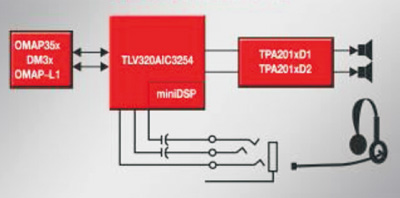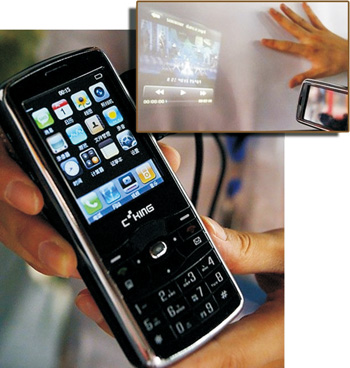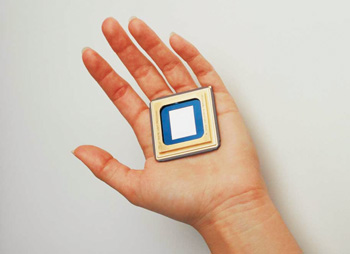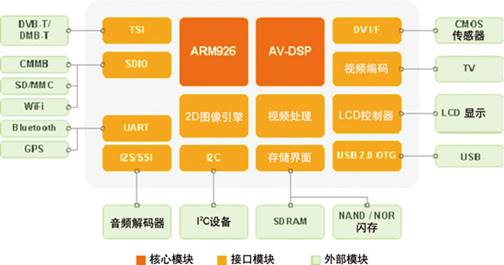When the so-called “cottage machine†of the domestic mobile phone market is flooding into large screens, stereo amplifiers, touch controls, and even GPS navigation and mobile TV, the homogenization between “cottage machines†and “brand machines†is becoming more and more serious. Mobile phones are only a microcosm of the portable product market, and the market for MP3, PMP and PND products are all caught in the fierce price war caused by homogenous competition. In order to take the quagmire of low-price competition, it is perhaps the only effective way to support differentiated competition with technological innovation. From interviews with some of the portable product chip design companies, we also found that there is still much room for improvement in terms of improving product performance, reducing power consumption, or functional innovation.
This article refers to the address: http://
Integrated DSP audio CODEC
A common phenomenon in the portable product market is that homogenized products force manufacturers to fight price wars in the market, and prices fall at the expense of quality. In addition, portable products are facing the challenge of compromising quality/function and power consumption, and the quality of audio processing is also difficult to escape the elbow of battery life.
The important means of realizing product differentiation competition in the current music mobile phone market is 3D surround sound, but limited by the size of the mobile phone, the stereo effect can not be achieved by simply adding a speaker. Some stereo music phones even use a 6-channel speaker, but they don't achieve stereo sound. This is because the distance between the two speakers is relatively close. Usually, the distance between the two speakers is 30 cm to achieve stereo sound.
Zhang Hongwei, business development manager for high-performance analog products in TI China, explained that it would be easy to run some stereo equalization algorithms at this time, but running this algorithm in an application processor would make a lot of work. Or someone needs to supervise the algorithm. Therefore, a small DSP can be added to the design of the audio CODEC, allowing the mobile phone to run complex algorithms while releasing MIPS on the application processor. For example, TI has integrated a 110MIPS miniDSP in the audio CODEC of the newly launched TLV320AIC3x series.
The advantage of the built-in DSP in the CODEC is that a complete algorithm library can be added to the DSP algorithm to optimize audio performance, such as echo cancellation, stereo equalizer, dynamic compression range, bass boost and loudness compensation. In order to combat noise, it can be combined with a dynamic range-compressed stereo amplifier to amplify small signals, reduce large signals, and resist noise interference, resulting in a smaller average loudness. Typical applications are noisy car navigation. In order to navigate clearly, designers usually increase the stereo power of GPS navigation devices to 1W or 2W. Some large-size GPS powers even reach 3W to 5W, which is not a burden on portable devices. Up.
For power consumption issues, the processor's power consumption can be modeled using different operating modes, allowing designers to trade off between low power and signal-to-noise ratios, such as TI's PowerTune technology. PowerTune firstly accurately knows the signal-to-noise ratio of the audio to be played through the processor, for example, setting the power consumption of the stereo ringtone as the priority, and setting the playing English learning material to the lowest power consumption mode. The CODECTLV320AIC3254 with PowerTune technology optimizes power consumption in any usage mode in stereo backhaul to 2.4 mW and consumes 5.1 mW in high fidelity music with 100 dB SNR.

Figure 1 Low-power audio CODEC with integrated miniDSP
Portable projection stepping out of the concept era
While improving audio quality, the industry is also looking for visual breakthroughs in portable products. On November 3, Wentai, the largest mobile phone design company in China, announced that it will cooperate with Taiwan's LCD driver chip maker Qijing to promote LCoS (silicon-based) projection mobile phones in the mainland market. Lenovo’s micro-projection chip, which can be integrated on various mobile devices, was presented at the Mobile World Congress 2008 in Barcelona, ​​Spain in February this year. It can be seen that the mobile phone projection has the meaning of breaking the mobile phone due to the limited screen size of the mobile phone. The narrow screen limit experience makes non-private information a better way to experience, share and display.

Figure 2 Shengtai launched the CKING projection mobile phone using the LDOS projection module of Red Butterfly Technology
In fact, many companies have already started research and development of key micro-projector chips. In addition to TI and some LCD driver chip design companies, companies such as Djin Display, Micro Precision, Microvision, Upstream Engineering, etc., which focus on display and optical technology. Research and development results have been made in the development of micro-reflective lens MEMS. Nokia, Motorola, Samsung, Canon and other mobile phone and projector manufacturers have also developed micro-projection components of a few millimeters thick and a few centimeters. At this year's Tianjin Mobile Show, the domestic Shengtai Technology also launched the world's first projection mobile phone with the support of optical device and optical module manufacturer Red Butterfly Technology.

Figure 3 TI's DLP chip for portable projectors
In terms of digital imaging processing technology for mobile phone projection, TI's independently developed DLP (Digital Optical Processor) technology has been proven in the projection display market, accounting for more than 30% of this market. At its core is the Digital Micromirror Device (DMD), which consists of millions of tiny mirrors that act as optical switches. Each mirror can be flipped back and forth (on or off) up to 5000 times per second. The input image or graphic signal is converted into a digital code, ie binary data consisting of 0 and 1. These codes are then used to drive the DMD mirror.
When the DMD seat plate works in conjunction with the projector, color wheel and projection lens, these flipped mirrors reflect a seamless digital image onto the TV screen. A piece of DMD is closely arranged by a number of tiny square reflecting lenses (micromirrors) in rows and columns, and then attached to the electronic nodes of a silicon wafer. Each micromirror corresponds to a pixel that generates an image. The number of micromirrors determines The physical resolution of a DLP projector.
The French company Yole Development and Canada's Chipworks jointly released a market report on optical processing cores and pico projectors. Chipworks analyzed the differences between TI's latest DLP devices and previous generations, highlighting its technological advances in wafer-level packaging and cell size reduction. TI replaces the original ceramic package with a wafer-level package to reduce packaging costs and reduce chip area by reducing pixel size. Yole Developpements used reverse cost analysis to see the new wafer-level packaging technology reduce costs by 50% (from about 400 to about $200).
Of course, TI's DLP advantage is also facing the challenge of his competitive technology. The LCoS microdisplay technology used in the CKING projection phone mentioned above is one of them. At present, dozens of companies around the world are actively developing this technology. Microvisions of the United States demonstrated a miniature color projector using LCoS technology at the Globalpress Electronics Summit in San Francisco in April 2008. Microvision's goal is to introduce a $400 stand-alone pico projector to the market in the fourth quarter of 2008 and to drop it to $100 in five years. Micro-projection modules integrated into mobile phones and laptops are also under development with a target price of less than $100.
LCoS is a new digital imaging technology. The basic imaging method is similar to the three-chip LCD liquid crystal technology. However, the projector using LCoS technology does not transmit light through the LCD panel, but uses reflection to form a color image. It uses a liquid crystal silicon-coated CMOS integrated circuit chip as a substrate for a reflective LCD, which is flattened by an advanced process and plated with aluminum as a mirror to form a CMOS substrate, and then the CMOS substrate and a glass substrate containing the transparent electrode. Fitted together, and then injected into the liquid crystal package. The LCoS places the control circuitry behind the display to increase light transmission for greater light output and higher resolution. The color gamut of the LCoS projection chip is very broad, and its color gamut range is much larger than that of CRT and DLP chips.
Compared with the relatively mature DLP, LCoS can only be calculated in the initial stage. Because LCoS display technology involves multiple cutting-edge technologies, mainly VLSI design and production processes, liquid crystal related technologies, optical engine technology, new optical disc technology, image processing related technologies, etc., it is difficult for a company to master all of these key technologies. But DLP and LCoS represent a new development trend in display technology, that is, the integration of micro-optical electromechanical systems (MOEMS) technology with solid-state lighting (LED, HVBLED, or laser diode) is a low-cost and compact optical engine. A new and unique solution.
Dual-core processors seize the mobile TV market
With the help of the 2008 Beijing Olympic Games, CMMB mobile TV has been booming, but the mobile TV in the post-Olympic era seems to have lost its development momentum. Currently, the TV programs are played in two forms. One is the Un-free FTA (Free To All), which usually covers public welfare or advertising content, which is very attractive to ordinary consumers; the other is to use CA encryption to receive. Including commercial media entertainment, interactive media broadcasting and professional data broadcasting, such value-added services are charged for service fees. As for the CA that joins the fee, whether it will affect the prospects of mobile TV still in the development stage, there is still doubt in the industry.
At least in the eyes of terminal dealers like the Patriots, the way to use partial content charges is more beneficial than harm. The Patriot's newly launched Walk TV CMMB digital TV receiving terminal combines CA conditional reception, interactive playback and real-time data broadcasting. A typical application example of Walk TV is to use mobile digital TV data broadcasting to transform the voice reception of traffic information broadcast into real-time video traffic information display.
What is surprising is that the Patriot's Walk TV processor does not extend the previous ARM-based Freescale i.MX platform, but uses Solomon Systech's dual-core multimedia processor SSD1933. The SSD1933 is the latest addition to Solomon Sysman's MagusCore portable multimedia processor, which integrates the ARM926EJ-S and AV-DSP on a single chip. The SSD1933 features an optimized dual-core distribution architecture that reduces power consumption during multimedia acceleration.
In fact, AV-DSP uses CEVA to provide MM2000 multimedia solution. The MM2000 SSD1933 can encode and decode a variety of standard video signals, including the highest D1 (720x576) resolution H.264 standard at 30fps. Combined with the MPEG-2 Transport Stream Interface (TSI). The MM2000's fully programmable architecture allows the SSD1933 to support a wide range of video formats including H.264, MPEG-4, WMV/VC-1, RMVB and up to D1 resolution H.263. In addition to the dual-core part, MagusCore includes a 2D graphics accelerator, camera interface, 24-bit LCD interface and an NTSC/PAL decoder for capturing and playing video and photos.
Choosing a single-core or dual-core processor architecture is more of a balance between solution flexibility and cost. According to Deng Guoyuan, CTO of Shenzhen Patriot, the Patriots have always used Freescale's i.MX platform. The mature products include the i.MX31-based solution, which is a 512MHz ARM11 processor core. It integrates a VGA resolution hardware video and image processor and a 2D/3D graphics accelerator to support playback of video formats such as RMVB, MVA, AVI and VGA, as well as 30fps, MPEG4@VGA video recording. Since then, in order to make up for the lack of multi-format video encoding and decoding capabilities of the i.MX processor, Freescale also officially released the i.MX27 in 2007, integrating ARM9 and H.264, MPEG4 hardware codec core.
For this dual-core solution using Solomon Systech, the Patriots are more willing to label the cooperation as "independent innovation." In early 2007, the Patriot Shenzhen Research Institute began a strategic cooperation with Solomon Systech to develop a mobile multimedia digital TV solution based on MagusCore. Beijing Huaqi CTO Fan Wei said: "The joint research project is mainly for core chip, mobile multimedia real-time operating system, software and hardware cooperative mobile digital TV multi-protocol source decoding software package, application software package development, is application, software and chip three Level of synergy.†The two parties defined this cooperation as “the chip design starts from the system application and ends with the complete embedded system softwareâ€.

Figure 4 Mobile TV terminal based on MagusCore
Fast Recovery Diode is a semiconductor device which possesses short reverse recovery time for rectification purpose at high frequency. A quick recovery time is crucial for rectification of high-frequency AC signal. Diodes are mostly used in rectifiers because they possess ultra-high switching speed.
Fast Recovery Diode
Fast Recovery Diode,Fast Recovery Rectifier Diode,Super Fast Recovery Diode,Fast Recovery Epitaxial Diode,Recovery Diode
YANGZHOU POSITIONING TECH CO., LTD. , https://www.yzpst.com